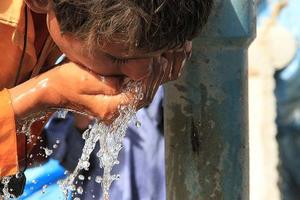WaterNew tool for incorporating water impacts into policy decisions
Just-released paper offers policy makers innovative framework for linking human well-being and water quality; a new tool helps in assessing and valuing the many services clean water provides — from recreation and beauty to navigation and hydropower — and incorporating them into policy decisions

Clean water needs to be part of policy-making decisions // Source: commons.wikimedia.org
If you have eaten fish, gone for a boat ride, or even taken a drink from the tap, you know clean water is a valuable commodity. Just how valuable, however? This has always been a tough question for policy makers to answer as they weigh the worth of clean water against societal needs that compromise it, such as the need to grow food or produce fossil fuels. A University of Minnesota release reports that now, however, their ability to do so has been greatly enhanced by a new policy-making framework developed by a team of scientists led by Bonnie Keeler, research associate at the University of Minnesota’s Institute on the Environment.
The framework, published in the 6 November issue of the Proceedings of the National Academy of Sciences, provides a tool for assessing and valuing the many services clean water provides — from recreation and beauty to navigation and hydropower — and incorporating them into policy decisions.
“After repeated requests for information on the value of water quality, we realized that there was a huge gap between the demand for economic values of water quality and our ability to provide tools to estimate those values. This gap limits our ability to make informed decisions,” Keeler said. “We provide a framework that describes the numerous pathways in which changes in water quality affect our health, recreation and livelihoods and the economic value of those changes.
This yields a far more accurate picture of the costs and benefits of decisions.”
Using funding from an IonE mini grant, Keeler and colleagues from the University of Minnesota, The Nature Conservancy, and the University of Arkansas began by developing a decision-making template that links actions, changes in water quality, changes in a spectrum of ecosystem goods and services, and changes in the economic value that accrues from the changes in ecosystem goods and services. They then outlined a five-step plan policy makers can use to apply the template to on-the-ground decisions around water issues.
“There will never be a single number that describes the value of clean water in all places and contexts,” Keeler said. “What our paper proposes is a way for users to link tools from ecology and economics to get value estimates that are specific to their location and sets of alternative actions. Ideally these values can then factor into incentive programs, cost-benefit studies and payment programs for ecosystem services.”
— Read more in Bonnie L. Keeler et al., “Linking water quality and well-being for improved assessment and valuation of ecosystem services,” Proceedings of the National Academy of Sciences 109 no. 45 (6 November 2012): 18619-24 (doi: 10.1073/pnas.1215991109)
